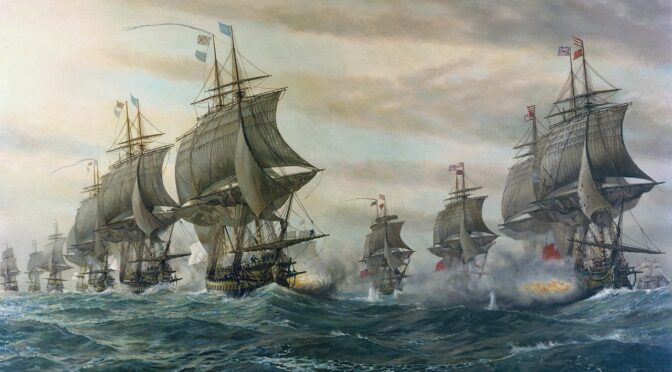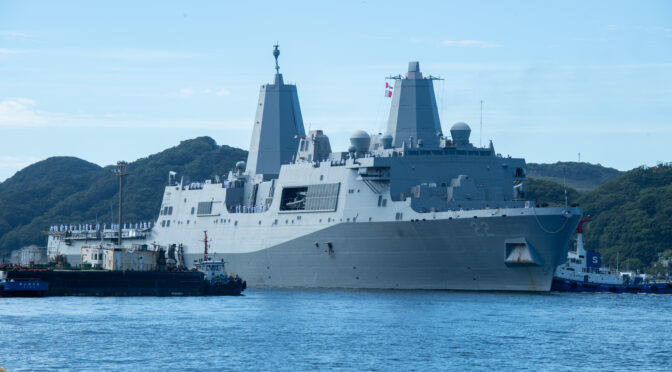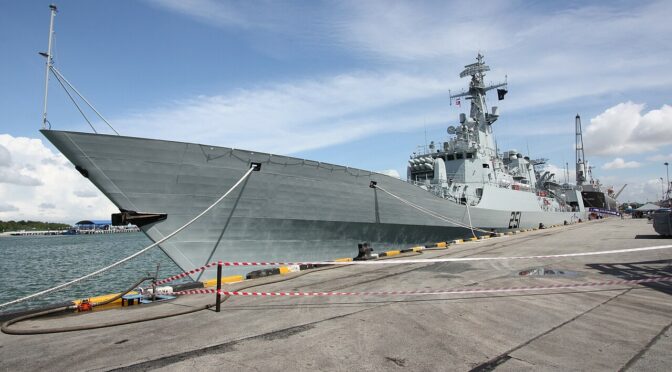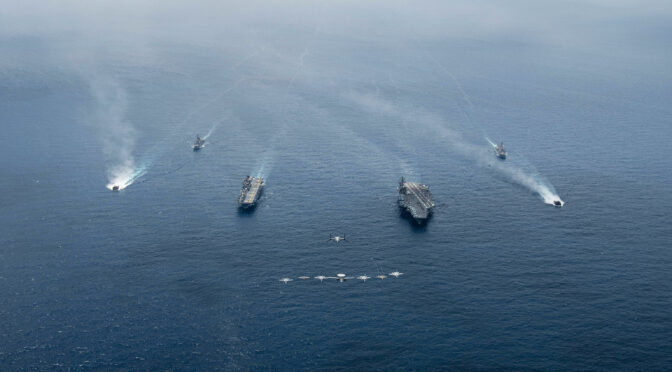By Alex Crosby
The 1778 French entry into the American War for Independence imposed several strategic conundrums for the British that fatally impaired chances of victory. First, French entry initiated a pattern of European opportunism to challenge British global hegemony, specifically with the cooperative involvement of France and Spain. Second, peripheral theaters in the West Indies, India, and Europe diffused British naval forces and strained limited manpower, devastating the British capability to conduct land warfare successfully. Finally, French entry bolstered American international legitimacy and domestic determination, which prevented Britain from regaining the strategic initiative. Ultimately, these combined challenges had adverse effects that made any remaining chance of British victory impossible.
European Opportunism
In the years leading up to its entry into the war, France aligned strategic resources to capitalize on opportunities that challenged British hegemony, particularly in the maritime domain. The French Secretary of State for Foreign Affairs, Vergennes, spearheaded ambitions to restore France to its perceived rightful dominant place in Europe by attacking British influence abroad instead of the historical strategy of targeting Britain itself.1 Additionally, both the French Director-General of Finance and Secretary of State for the Navy, Jacques Necker and Gabriel de Sartine, respectively, established policy decisions from 1774-1780 that supported France’s ability to pay for domestic war support, including the robust reformation of its naval forces.2 This preparation allowed France to be generally well suited to confront British naval forces, a physical representation of British hegemony, and directly contributed to British defeats in the maritime domain.
Following the commencement of the war, France identified the unique opportunity this far-off conflict presented for restoring order and balance to European power dynamics, which would also weaken British military successes. Specifically, the strained state that British forces were in following the Saratoga and Philadelphia campaigns provided the ideal timing for the French to enter the war. While Britain was considering negotiations to cease hostilities after these two campaign failures, France sought to prolong the war for its own benefit.3 France had long desired a revengeful opportunity to damage Britain in a manner that would increase maritime and political superiority in France’s favor.4 The tyranny of distance associated with European conflict in North America was capitalized on by France and continued to be a monumental struggle for Britain.
France’s entry into the war placed it in the unique position of being able to leverage American Revolutionary aims for independence as the catalyst for its grand strategy to challenge British hegemony and defeat it when opportunities presented themselves. Although France had expressed genuine interest in the American colonies seeking independence, this disturbance ultimately served France as a lever to restore global colonial balance and French influence.5 France embodied its role as a catalyst for challenging British hegemony and, in doing so, spurred Spain and Holland into later cooperation to ensure British victory in the American War for Independence would be impossible.
Motivated by decades of simmering retaliation and individual self-identification as the rightful European hegemon, France’s entry into the war forced Britain into a defensive maritime fight that prevented victory after 1778. Since 1763, the French-led House of Bourbon had been conducting robust shipbuilding efforts with the anticipation of likely conflict with Britain’s notoriously strong naval fleet. Unburdened by any land warfare entanglements in Europe, the House of Bourbon majorly oriented its resources towards increasing its combined maritime power.6 By 1775, France and Spain’s relative combined naval power exceeded Britain by approximately 25 percent and continued to grow throughout the remainder of the war.7 This prioritization of the maritime domain forced Britain into a strategic defensive posture, with alternating concerns between the North American land campaigns and countering Bourbon maritime threats across the globe.8
Peripheral Theaters
French entry into the American War for Independence created pervasive and politically deadly dilemmas for British control of its far-flung naval bases and ports across the globe.9 Except for the Spanish-controlled naval shipbuilding port of Havana, overseas locations for European countries were typically resource deficient and required significant garrison forces to maintain order.10 The vast distances and garrison requirements complicated British efforts to counter French attempts at harassment, isolation, or invasion. Due to French threats to British colonial garrison forces and the maritime sea lines of communication between them, Britain reoriented its forces and resources towards France and decreased allocations to combating the American colonialists.11 Britain eventually further ensured its strategic defeat with its declaration of hostilities on Holland. France capitalized on the resulting Fourth Anglo-Dutch War and gained a critical extension of control into the Indian Ocean and West Indies.12 This unification of European powers, led by France, signaled a shift in global British control and turned the weight of Britain’s colonial possessions won during the Seven Year’s War in 1763 into an overwhelmingly taxing drain that prevented the British from bringing its full combat potential to bear at the locations of its choosing.13
France’s entry also led to the defense of Britain becoming the primary strategic objective when threats of attack from the House of Bourbon culminated between 1778-1780.14 In particular, the British Admiralty tended to be riveted by fears of potential invasion and over-insured home waters with British naval forces that could have proved decisive elsewhere.15 This fear was further flamed as Britain entered hostilities without any continental allies.16 Despite focusing maritime forces in its home waters, the British navy would have had no legitimate chance against a combined Franco-Spanish naval fleet if they had pursued a determined invasion of Britain. Britain’s shift from offensive operations in the American colonies, King George’s original strategic objective, to defensive operations displayed the genuinely destructive nature of French entry into the war.
Due to this refocusing towards Europe, Britain overly fixated on French naval dockyards in their misguided pursuit of a decisive naval engagement.17 The First Lord of the Admiralty, John Montagu, preferred concentration of the British naval fleet in Europe to force the House of Bourbon alliance to reallocate their respective naval forces from North America and the West Indies. However, the British navy lacked proper military intelligence on the intentions of enemy fleet movements.18 This intelligence gap resulted in the British fleet predominately failing to locate and engage the House of Bourbon naval forces. Additionally, France exploited its geographical position to facilitate an increasing operation focusing on guerre de course to harass British shipping.19 This missed opportunity of British naval forces countering France at sea allowed the French to operate with general freedom of action and inflict terminally damaging economic and military costs on Britain.
Bolstered Americanism
American Revolution leaders had framed their political narrative as a legitimate protest movement with traditional values grounded in English law and classical political philosophy to protect against British accusations and attract powerful European political and intellectual elites’ support.20 This political narrative would result in an increasing European acknowledgment of American Revolution legitimacy in the international system, albeit initially limited. Additionally, the radical changes in principles, opinion, sentiments, and affections of people from the republican ideals in the Declaration of Independence improved American legitimacy and furthered domestic determination. The American Revolution leadership hoped that a potential French recognition of an established United States of America would pave the way for other European nations to join the war and understand the long-term economic benefits of a British defeat.21 By incorporating principles of English society into their cause, the American revolutionaries had created a brilliant situation where British resentment fueled a growing fire of emboldened Americanism. Having been satisfactorily impressed by the intricate efforts of the American Revolution leadership like Benjamin Franklin, France became the spark that lit the eternal fire of American determination to defeat Britain.22
American leadership had long depended on France’s entry into the war and recognized the significance it would have on inhibiting Britain’s chance of victory. Even in the darkest moments after conflict initiation, George Washington remained faithfully committed that a French entry would inevitably occur. Specifically, Washington understood that the strategic complication of Britain fighting a land battle in the American colonies and contending with French naval forces across the globe would ensure a British defeat.23 American leadership hoped that the British failure during the Saratoga Campaign would be a turning point for French war support, which proved valid with France’s entry shortly afterward.24 Further hopes of a more meaningful alliance and a long-awaited desire to decisively defeat the British would come to fruition in August 1781 at the Battle of Yorktown with a sixteen thousand man-strong combined force of French and American troops.25
France’s entry also brought tangible aid to the American colonists that ensured war efforts could continue and drain Britain’s overseas land combat potential. French military leaders identified that the American colonists organically possessed relatively proficient skills with handling weapons and that they maintained the ability to fight in the near-limitless space across the American colonies. Additionally, France perceived the American colonists as being fearless of losing cities as they had no legitimate political, moral, or industrial foundation for military efforts, unlike the cities of Europe.26 This unique degree of American colonial resolve to reach war termination in their favor spurred on French, Spanish, and Dutch military aid in the forms of gunpowder, loans, and various equipment.27 Specific to the French, the first shipment crossed the Atlantic Ocean just after conflict initiation in 1776 clandestinely through a fabricated commercial entity and continued until war termination.28 The tangible aid that came with French entry, combined with the character of American warfighting, sapped British land forces of necessary combat potential.
In addition to tangible military aid, France provided a maritime-based capability to project power shore and inflict military costs on the British. While the American colonists focused almost exclusively on land warfare to drain British military resources, France focused its military efforts at sea.29 This French naval strategy ideally supported land operations and had been doctrinally implemented with the anticipation of a potential war with Britain in the American colonies.30 The September 1779 French fleet bombardment of Savannah displayed this ability against British land targets, and although limited in tactical success, contributed to furthering American determination against Britain.31 Following French entry, British naval and land combat potential in North America would never recover to 1776 levels.32
Although traditional American naval action was limited during the American War for Independence, French entry bolstered American privateering against British shipping and the land pressuring of naval bases, providing morale boosts that kept American colonial determination strong. Before there was a French naval presence on the Atlantic Coast, British sea control was locally uncontested and prevented consistent privateering near the coastal waters.33 American privateering increased and challenged British maritime security efforts once French naval forces provided limited sea control.34 The presence of Comte d’Estaing’s ships forced Britain to abandon blockade efforts, which dramatically increased opportunities for privateering and the flow of European goods shipments.35 This privateering went practically uncontested by the British for the remainder of the war and highlighted the general decrease in British maritime superiority upon French war entry.36 Additionally, French entry spurred American determination to put pressure on and control the naval hubs of Boston, Narraganset Bay, and New York.37 The threat of privateering and loss of strategically important naval bases in North America, enabled by the French, directly contributed to overall British defeat in the American War for Independence.
Contrarian Viewpoint
Some might argue that the House of Bourbon alliance was fragmented between drastically different political objectives, leading to opportunities for Britain’s exploitation and regaining the initiative towards achieving favorable war termination. This fragmentation is supported by French awareness of the necessity for Spain to provide resources for a combined naval force to place the British naval fleet at risk. Likewise, Spain was exceptionally aware that France depended on their involvement and actively leveraged this to steer the House of Bourbon alliance to achieve its land seizure objectives. Spain had specific war objectives of seizing Minorca, Gibraltar, and Jamaica from British control but was generally less committed to holistically orienting strategic resources towards successful operational execution.38 Additionally, Spain contrasted France in that it had no intentions of supporting the Americans or recognizing their moves towards independence.39 Finally, Spanish political resolve for conflict was limited and nearly led to withdrawal from the war following Spanish failure at Gibraltar.40 This vulnerable situation required France to direct resources to maintain a particular strategic objective of preventing Spanish capitulation from hindering French benefit or enabling a British victory.41
Despite these contrary views, these opposing objectives were overcome by an overall common unity to challenge British hegemony and cause culminating burdens. Neither France nor Spain were aggressively opposed to each other’s objectives and successfully found compromise to leverage each other’s military advantages. In particular, Spanish renewed efforts to pressure Britain in the West Indies allowed France to increase maritime and power projection operations in North America.42 France and Spain were deeply bound by desires for reprisal against British actions several decades prior and held sentiments of European rightfulness to supersede British hegemony.43
Additionally, others might argue that British naval forces were doctrinally and capability superior to their French equivalents, which could have led to a British victory. In general, British naval forces were able to maintain a degree of local sea control around their sea lines of communication, thus ensuring the strategic sustainment of its North American land forces. Likewise, the British were confident in their naval superiority and assessed that one or two decisive maritime engagements would have terminally altered the threat of the Franco-Spanish naval fleet and regained the complete strategic initiative in British favor.44
While this perspective holds some merit, British strategic decisions like those made by George Germaine, the British Secretary of State for the Colonies, had severely limited British maritime strategy.45 British fears of upsetting France and British taxpayers that response to the American rebellion was a prelude to invading the French West Indies led to limited naval mobilization in 1775. These limitations were also coupled with broad navy funding cuts and rules of engagement additions that dictated there be no interception of French ships carrying munitions and supplies to the American colonies. These measures ultimately negated any possibility of a successful blockade on the Atlantic Coast being effectively implemented.46
Additionally, the French recognized the immense risks of becoming involved in a decisive naval battle with the British and instead focused efforts on attacking seaborne trade, launching land assaults against colonial possessions, enhancing French overseas control, and escorting French trade.47 Compounding the problem of France not being a cooperative target set, the British failed to internally coordinate intelligence of French and Spanish naval dockyards, which led to the House of Bourbon operating with near impunity across the Atlantic Ocean.48 With French entry pressing Britain into an overly defensive posture, British naval forces became too burdened by global mission tasking to guarantee local sea control of its Atlantic Ocean sea lines of communications.49
Finally, the British would have ultimately had to prioritize the North American theater over its other colonies to mitigate the risk posed by the combined French-Spanish naval forces. This prioritization would have suicidally sacrificed British economic priorities in other colonies, such as the West Indies, which had become a focal point of French maritime operations.50 Likewise, British naval focus on protecting the homeland was predicated on poor strategic assumptions that France intended to conduct an amphibious landing. Although there were discussions within the House of Bourbon to conduct such an invasion, this strategy was smartly abandoned for a more appropriate increase in maritime trade interdiction that would place Britain at greater strategic risk. Additionally, the British land forces in North America contended with unparalleled exterior lines of communication that measured more than three thousand miles across the Atlantic Ocean.51 This vast distance required overseas locations, with corresponding garrison forces, that Britain could not maintain after French entry.52 Ultimately, French entry into the American War for Independence in 1778 negated any possibility of Britain achieving victory.
Lieutenant Commander Alex Crosby, an active duty naval intelligence officer, began his career as a surface warfare officer. His assignments have included the USS Lassen (DDG-82), USS Iwo Jima (LHD-7), U.S. Seventh Fleet, and the Office of Naval Intelligence, with multiple deployments supporting naval expeditionary and special warfare commands. He is a Maritime Advanced Warfighting School–qualified maritime operational planner and an intelligence operations warfare tactics instructor. He holds master’s degrees from the American Military University and the Naval War College.
Endnotes
[1] Pritchard, James. “French Strategy in the American Revolution: A Reappraisal.” Naval War College Review, vol. 47, no. 4 (Autumn 1994): 86-87.
[2] Ibid., 85.
[3] Ferling, John. Whirlwind: The American Revolution and the War That Won It. New York: Bloomsbury Press, 2015: 207.
[4] Mahan, Alfred Thayer. The Influence of Sea Power upon History, 1660-1783. Boston: Little, Brown and Company, 1890: 510-513
[5] “French Strategy in the American Revolution: A Reappraisal.” 88.
[6] The Influence of Sea Power upon History, 1660-1783. 505.
[7] O’Shaughnessy, Andrew Jackson. The Men Who Lost America: British Leadership, the American Revolution, and the Fate of the Empire. New Haven: Yale University Press, 2013: 343.
[8] The Influence of Sea Power upon History, 1660-1783. 508.
[9] Ibid., 511.
[10] Ibid., 520.
[11] Ibid., 520.
[12] Ibid., 521.
[13] Jasanoff, Maya. Liberty’s Exiles: American Loyalists in the Revolutionary World. New York: Knopf, 2011: 24.
[14] The Men Who Lost America: British Leadership, the American Revolution, and the Fate of the Empire. 14.
[15] Mackesy, Piers. “British Strategy in the War of American Independence.” Yale Review, vol. 52 (1963): 555.
[16] The Men Who Lost America: British Leadership, the American Revolution, and the Fate of the Empire. 334.
[17] The Influence of Sea Power upon History, 1660-1783. 526.
[18] The Men Who Lost America: British Leadership, the American Revolution, and the Fate of the Empire. 333-334.
[19] Mahan, Alfred Thayer. “Introductory” and “Discussion of the Elements of Sea Power.” In Mahan on Naval Strategy. John B. Hattendorf, ed. Annapolis: Naval Institute Press, 2015: 33
[20] Genest, Marc. “The Message Heard ‘Round the World.” In Quills to Tweets: How America Communicates about War and Revolution. Andrea J. Dew, Marc A. Genest, S.C.M. Paine, eds. Washington, D.C.: Georgetown University Press, 2019: 10.
[21] Whirlwind: The American Revolution and the War That Won It. 205-206.
[22] The Men Who Lost America: British Leadership, the American Revolution, and the Fate of the Empire. 114.
[23] Whirlwind: The American Revolution and the War That Won It. 205-206.
[24] Liberty’s Exiles: American Loyalists in the Revolutionary World. 40.
[25] Ibid., 52.
[26] British Strategy in the War of American Independence. 541.
[27] The Men Who Lost America: British Leadership, the American Revolution, and the Fate of the Empire. 14.
[28] Whirlwind: The American Revolution and the War That Won It. 205-206.
[29] The Influence of Sea Power upon History, 1660-1783. 508.
[30] French Strategy in the American Revolution: A Reappraisal. 91.
[31] Liberty’s Exiles: American Loyalists in the Revolutionary World. 44.
[32] The Men Who Lost America: British Leadership, the American Revolution, and the Fate of the Empire. 14.
[33] Ibid., 333-334.
[34] Ibid., 343.
[35] French Strategy in the American Revolution: A Reappraisal. 93.
[36] Whirlwind: The American Revolution and the War That Won It. 209.
[37] The Influence of Sea Power upon History, 1660-1783. 520.
[38] Ibid., 510.
[39] French Strategy in the American Revolution: A Reappraisal. 87.
[40] Ibid., 94.
[41] Ibid., 96-97.
[42] Ibid., 99.
[43] The Influence of Sea Power upon History, 1660-1783. 509.
[44] British Strategy in the War of American Independence. 554.
[45] Ibid., 548.
[46] The Men Who Lost America: British Leadership, the American Revolution, and the Fate of the Empire. 13-14.
[47] French Strategy in the American Revolution: A Reappraisal. 92.
[48] The Men Who Lost America: British Leadership, the American Revolution, and the Fate of the Empire. 346-347.
[49] British Strategy in the War of American Independence. 541.
[50] The Influence of Sea Power upon History, 1660-1783. 513.
[51] British Strategy in the War of American Independence. 543.
[52] The Influence of Sea Power upon History, 1660-1783. 515.
Featured Image: Battle of the Virginia Capes, 5 September 1781. Oil on canvas by v. Zveg, 1962, depicting the French fleet (at left), commanded by Vice Admiral the Comte de Grasse, engaging the British fleet (at right) under Rear Admiral Sir Thomas Graves off the mouth of Chesapeake Bay. (Courtesy of the U.S. Navy Art Collection, U.S. Naval History and Heritage Command Photograph)




